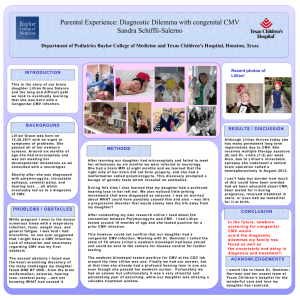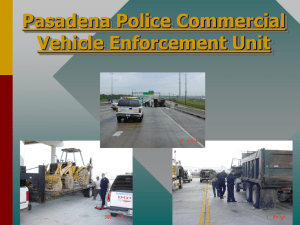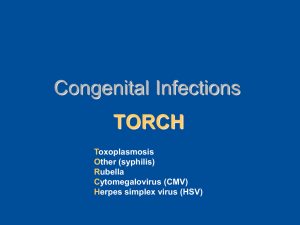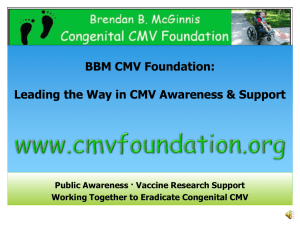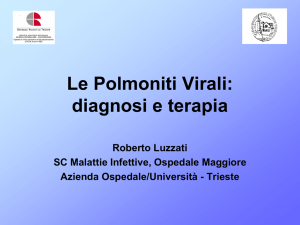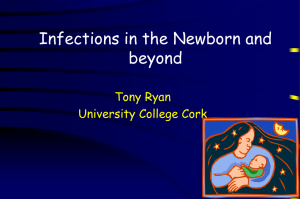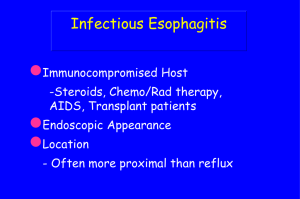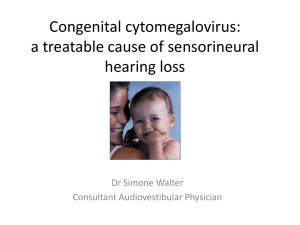Cytomegalovirus infection in patients
advertisement
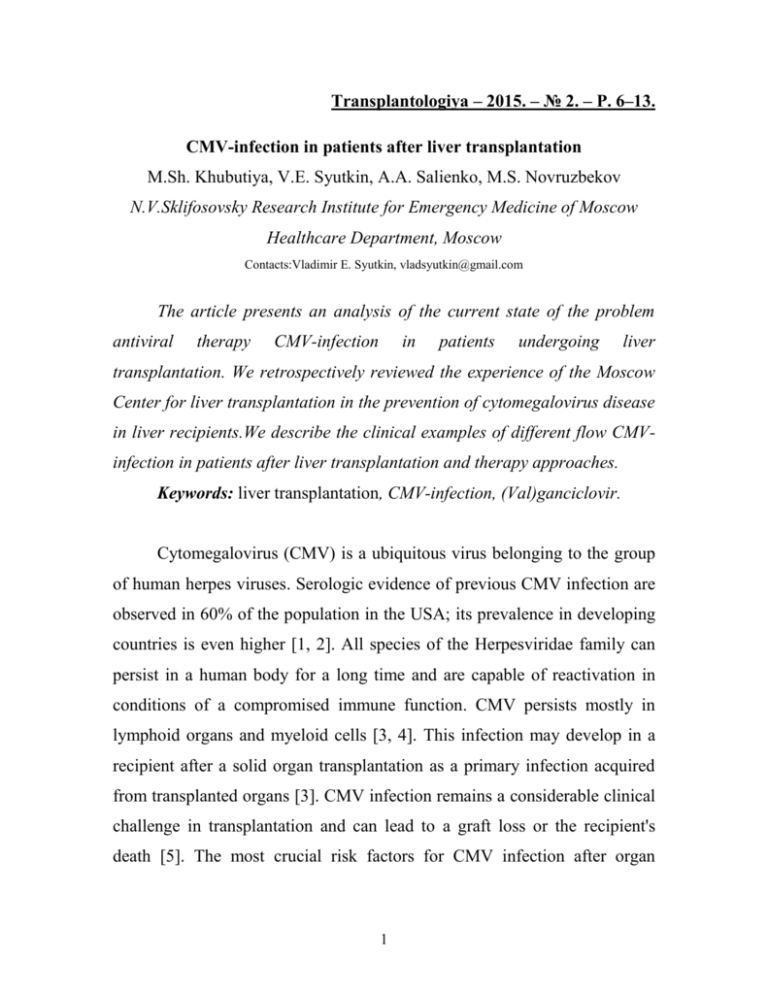
Transplantologiya – 2015. – № 2. – P. 6–13. CMV-infection in patients after liver transplantation M.Sh. Khubutiya, V.E. Syutkin, A.A. Salienko, M.S. Novruzbekov N.V.Sklifosovsky Research Institute for Emergency Medicine of Moscow Healthcare Department, Moscow Contacts:Vladimir E. Syutkin, vladsyutkin@gmail.com The article presents an analysis of the current state of the problem antiviral therapy CMV-infection in patients undergoing liver transplantation. We retrospectively reviewed the experience of the Moscow Center for liver transplantation in the prevention of cytomegalovirus disease in liver recipients.We describe the clinical examples of different flow CMVinfection in patients after liver transplantation and therapy approaches. Keywords: liver transplantation, CMV-infection, (Val)ganciclovir. Cytomegalovirus (CMV) is a ubiquitous virus belonging to the group of human herpes viruses. Serologic evidence of previous CMV infection are observed in 60% of the population in the USA; its prevalence in developing countries is even higher [1, 2]. All species of the Herpesviridae family can persist in a human body for a long time and are capable of reactivation in conditions of a compromised immune function. CMV persists mostly in lymphoid organs and myeloid cells [3, 4]. This infection may develop in a recipient after a solid organ transplantation as a primary infection acquired from transplanted organs [3]. CMV infection remains a considerable clinical challenge in transplantation and can lead to a graft loss or the recipient's death [5]. The most crucial risk factors for CMV infection after organ 1 transplantation include the Donor (D+)/Recipient (R-) serological status, and the intensity of immunosuppression [1]. Recommendations of international expert groups distinguish between "CMV infection" defined as the presence of proteins and DNA virus in biological fluids and tissues regardless of the presence or absence of clinical symptoms, and "CMV disease" defined as the development of clinical symptoms in the presence of virus replication [6]. In turn, the clinical effects of the CMV-induced disease may be direct or indirect. The direct CMV effects are manifested as fever, weakness, depression of bone marrow hematopoiesis. The complex of these symptoms is often referred to as CMVsyndrome [6, 8] that is seen in a majority of CMV-disease cases. The CMVdisease may be associated with more severe effects such as the visceral organ involvement, specifically the graft and the gastro-intestinal tract. The indirect effects of CMV infection include the increased graft rejection rate, further strengthening of immunosuppression that contributes to the development of opportunistic bacterial, fungal, viral infections, a more rapid progression of hepatitis C, and the development of post-transplant lymphoma. Two main approaches have been proposed to prevent clinical manifestations of CMV infection after orthotopic liver transplantation (OLT): a universal prophylaxis with valganciclovir for 3-6 months after the OLT and a pre-emptive therapy (monitoring for blood CMV DNA or pp65 protein and administering a short course of therapy only if they are detected). Each of these approaches has advantages and disadvantages. The main shortcoming of the universal prophylaxis is that it can delay the onset of CMV disease to a more remote time period, when the disease is no longer expected by the clinicians; in other words, after CMV DNA monitoring has 2 been ceased. This delayed CMV disease is associated with increased total and infection-associated mortality rates after OLT. There are other problems of prophylaxis associated with valganciclovir cumulative toxicity related to its long-term exposure. Moreover, a prolonged use of valganciclovir as a universal prophylaxis contributes to the emergence of ganciclovir-resistant viral strains which seriously hampers the subsequent treatment. The preemptive therapy strategy entails the main risk of an ultra-fast development of CMV-infection clinical signs after the viral DNA has been detected in blood; but such cases are rare. According to the guidelines of The Transplantation Society (TTS) and the American Society of Transplantation (AST), the efficacy of the pre-emptive therapy is not inferior than that of the prophylaxis, that is also true for high-risk groups (i.e., in the recipients without signs of previous CMV infection, and with antibodies being detected in donor's blood) [7, 8]. Many experts still prefer to restrict the use of preemptive therapy to the groups of recipients with moderate and low risk of CMV disease, only (i.e. the patients who have symptoms of previous CMV infection or in the cases where the donor and recipient are seronegative for CMV antibodies). In the present study, we retrospectively reviewed the experience of the Moscow Center for Liver Transplantation (MCLT) in prevention of CMV disease in liver transplant recipients. The approaches to detect a CMV infection after OLT in MCLT have changed over time. Study objective: To define the timing and the incidence of CMV infection in liver transplant recipients and to evaluate the efficacy of pre- 3 emptive therapy with (val)ganciclovir in the prevention of CMV infection complications. Patients and Methods Reviewing the data on postoperative course in patients after OLT performed in MCLT in the period from September 2000 to July 2014 (300 transplantation procedures), we studied the rate of serum CMV DNA detection by a real-time polymerase chain reaction. Prophylaxis against the CMV infection was undertaken in none of the cases. During the study period our resources and established procedures to make routine CMV DNA determinations in blood changed several times. Taking into consideration the varied approaches to diagnose the CMV infection, we may distinguish three time periods. The first 35 OLTs were performed in MCLT from September 2000 to May 2006. Blood assays for CMV DNA were made regularly once a month for at least 6 months after the OLT. From June 2006 to November 2011, the following 165 OLTs (from the 36th to the 200th procedure) were performed. In that period, blood assays for CMV DNA were less frequent (once or 2-3 times in the first 6 months after surgery). In 58 recipients, blood was not studied for CMV DNA in the first six months following OLT. Finally, in the period from December 2011 to July 2014, the following 100 OLTs (from the 201st to 300th procedure) were performed; and the outcomes have been investigated in the present paper. During that period, the CMV DNA determinations in blood were made from week 2 post-surgery and further on regularly with an interval not exceeding 2 weeks up to month 6. Recipients who did not survive the initial 14 postoperative days were excluded from the analysis. 4 The presence of neutropenia and leukopenia was defined as a CMVsyndrome manifestation in the cases when white blood cell (WBC) count and/or neutrophil count decreased by 30% or more from baseline on the first day of CMV DNA detection in blood. The graft dysfunction (GD) was defined as an increase in ALT and/or AST activities 1.5-fold from the upper limit of reference values or as a 1.5 increase in transaminase activities from the baseline if elevated. The cases of early CMV DNA detection (in the first post-OLT month) were not regarded as GD when the increased ALT and AST could be explained by the ischemia-reperfusion injury of the graft, and there was clearly a strong tendency to a decrease in their activity. Treatment with ganciclovir or valganciclovir (from May 2009) was administered for 3-8 weeks if CMV DNA had been detected in blood. The total therapy duration was determined with regard to the timing when the CMV DNA ceased to be detectable in blood. Following the first negative study for CMV DNA, the antiviral therapy (AVT) was continued for a week, and was terminated after the absence of CMV DNA in blood serum had been reconfirmed. A recurrent CMV infection after the initial AVT course was defined as a CMV DNA detection a month or more later after AVT completion. Statistical processing of digital values was performed using the Statistica 8.0 Software (StatSoft, Inc., USA). The results of calculating the time of the first CMV DNA detection in blood have been presented as the means, medians, and 95% confidence intervals (95% CI). The significance of differences between the compared variables was determined by Chisquared test (with Yates' correction) for comparison of proportions. Differences were considered statistically significant if the p value was less than 0.05. 5 Results The incidence of CMV DNA detection in different periods of MCLT activity is presented in the Table. Table. The incidence of CMV infection, and clinical symptoms in liver transplant recipients Number Period of recipients 09.200005.2006 06.200611.2011 12.201107.2014 Died in initial 14 post-OLT days 35 8 165 25 100 8 CMV DNA CMV not DNA investigated detected 1/27 (4%) 15/26 (58%) 61/140 24/79 (44%) (30%) 7/92 (8%) CMV CMV-graft syndrome dysfunction 1/15 (7%) 2/15 (13%) 2/24 (8%) 2/24 (8%) 29/85 9/29 (34%) (31%) 3/29 (10%) In the period from 2000 to May 2006 CMV DNA was detected in 15 (58%) of 26 recipients who survived the early postoperative period. Four patients showed the signs of GD, however, CMV DNA was detected in the presence of acute hepatitis C, cholangitis, biliary anastomosis incompetence, and after acute cellular rejection, and pulse glucocorticoid therapy (PGT). The CMV infection was the single cause of GD in 2 recipients only. In 6 cases, the CMV DNA became detectable in blood of the recipients after PGT undertaken for the proven or suspected cellular rejection. 6 The most "problematic" period for CMV DNA detection was from June 2006 to November 2011 when among 140 liver transplant recipients who survived the first 2 weeks after OLT, 61 (44%) were not investigated for DNA CMV. CMV DNA was detected in blood of 24 (30%) of 79 liver recipients investigated (at least once). During that period, we have seen two (!) GD cases caused solely by CMV infection, in 2 other cases, the CMV infection was manifested as an enteritis pattern. In 2 patients, the clinical presentation was limited to the signs of CMV-syndrome without the invasive disease. In 4 cases, CMV DNA was detected in patients with active hepatitis C in the presence of GD. In one more patient, CMV DNA was found due to inadequate immunosuppression, and another one had the CMV DNA detected with the development of chronic rejection after PGT. Finally, 100 more OLTs were performed from December 2011 to June 2014. Blood serum was not investigated for CMV DNA only in 7 of 92 liver recipients who survived longer 2 weeks following the OLT. CMV DNA was detected in 29 (34%) of the 85 liver transplant recipients, meanwhile, the clinical signs of CMV infection were seen in 13 of 29 recipients with detected CMV DNA. There was 1 case of enteritis presentation, 3 cases of hepatitis, and 9 patients among those 13 had CMV-syndrome manifestations only. None of the liver transplant recipients had CMV DNA in the presence of GD associated with other causes. In most cases (36 of 68), the CMV DNA detection was not associated with the CMV-syndrome development, GD, or any other clinical manifestations of the disease. Among 10 cases of GD attributable to causes different from CMV infection, the CMV infection was accompanied by CMV-syndrome symptoms in 1 case only. The incidence of CMV infection and some of associated clinical signs are presented in the Table. 7 CMV DNA was first detected in blood at mean 1.9 months (median 1.5 months; 95% CI for the mean: 1.2, 2.6 months). In most cases CMV DNA was first documented in the first (n=23; 33.8%), and second (n=30; 44.1%) months after OLT. The rates of CMV DNA detection for the first time in the 3rd, 4th, and following months after OLT were 11.8%, 4.4%, and 5.9%, respectively. Ganciclovir (5-7 mg/kg) or valganciclovir (900 mg/day) with regard to the glomerular filtration rate (GFR) was administered to all recipients with CMV DNA detected in blood. The therapy duration was at least 21 days. The treatment was withdrawn in the cases where two consecutive tests for CMV DNA made with a week interval were negative. The therapy with these drugs was efficient in all the patients, except for one who developed ganciclovir-resistant CMV infection. Here we describe the case. M., born in 1961, underwent an OLT for alcoholic liver cirrhosis on October 21, 2013. On the first day after the OLT, he developed a bleeding from the arterial anastomosis that required relaparotomy with suturing the bleeding area. The postoperative course was associated with a mild ischemic-reperfusion injury, with ALT and AST having returned to normal values by the 10th postoperative day. The patient was discharged from hospital in a satisfactory condition at day 18 after OLT. The patient was on a standard immunosuppressive therapy that included basiliximab, mycophenolic acid (720 mg/day), and tacrolimus. Blood level of tacrolimus at the time of discharge from the hospital was 10 ng/mL. At a scheduled follow-up on November 27, 2013, CMV DNA was detected in blood that was accompanied by ALT increase to 61 IU/mL and a WBC count decrease from 4000 to 3400 cells/mcL. Given the decline in GFR (40 mL/min), the patient was given an oral valganciclovir in a daily dose of 450 mg. Over the 8 next 4 weeks, CMV DNA in blood continued to be detectable, but ALT and AST activities returned to normal values. The dose of tacrolimus was tapered so that the blood level of the drug would not exceed 6 ng/mL. As far as valganciclovir appeared ineffective, the patient was switched to intravenous ganciclovir in the period from December 20th to 30th, 2013 and received it at a maximal possible (with regard to GFR being 30-40 mL/min) daily dose of 500 mg. He demonstrated satisfactory tolerance of the therapy, but CMV DNA continued to be detectable in blood. As the situation clearly went beyond the standard scenario, we performed a quantitative CMV DNA testing on January 15, 2014, (demonstrating 10,000 CMV copies per milliliter of plasma). The patient GFR had increased to 67 mL/min by that time, and the therapy with valganciclovir was resumed at a dose of 900 mg/day. After a repeated quantitative CMV DNA assay on February 5, 2014 (38 000 copies/mL), the patient was admitted for in-hospital treatment with ganciclovir at a dose of 20 mg/kg (1000 mg/day) in combination with human anti-CMV immunoglobulin (Cytotect). Tacrolimus dose was reduced again, and mycophenolic acid was disconutnued. CMV DNA continued to increase over time: from 119 000 copies/mL on February 27, to 153,000 copies/mL on March 27). Worthwhile to note, the patient showed a satisfactory tolerance of therapy though a moderate leukopenia (2300 cells/L) was revealed that could be explained either as caused by CMV infection as a ganciclovir side effect. There were no other clinical manifestations of CMV infection, GD, or drug toxicity. Unfortunately, we were unable to perform a genotypic assay to identify the CMV resistance to ganciclovir, but the lack of response to therapy for 4 months was the reason for us to regard the case as a ganciclovir-resistant infection. A recommended alternative therapy to ganciclovir in such cases would be foscarnet that was given to the patient at 9 a dose of 90 mg/kg twice a day, starting from April 1, 2014, with the close monitoring of renal function and blood electrolyte levels. The drug was administered for 21 days as a peripheral vein infusion at a low rate, preliminary being diluted in dextrose and prehydrated. On the 7th day of therapy, the CMV DNA level was 7900 copies/mL; at day 14, the test for CMV DNA became negative. CMV replication was not renewed in the patient for a 1-year follow-up. In another male patient, a resident in the Stavropol region, who underwent an OLT for hepatitis B-related liver cirrhosis at the age of 44, CMV DNA was detected on the 51st postoperative day without any clinical signs of infection or GD. Valganciclovir therapy was recommended, but the patient did not receive it (!), as we learned only at his follow-up visit to the MCLT 2 months later. CMV DNA ceased to be detectable in blood spontaneously and was steadily undetectable for the following 5 years. The incidence of CMV DNA detection was unrelated to the cause that led to OLT and ranged from 19% (in patients with viral hepatitis B and C) to 30% (in patients with primary sclerosing cholangitis and autoimmune hepatitis). We found no correlation between CMV infection and sex of the patients, or immunosuppression type (calcineurin inhibitor, everolimus therapy). Among 68 cases of CMV infection detected and successfully treated there were 18 (26.5%) cases or recurrent infection. In 13 of 18 recipients, a recurrent CMV infection occurred in the first 6 months after the OLT. In the other cases, CMV DNA recurrence was observed at 7-12 months after the OLT, except for one female patient in whom CMV replication recurred at 23 months after OLT, 2 months after the delivery of a healthy baby. CMV DNA recurrence was without clinical manifestations in 9 patients was associated 10 with CMV syndrome in 2, with CMV-related hepatitis in 3; other 4 patients had recurrent CMV replication in the presence of GD due to other causes (HCV, biliary complications, autoimmune hepatitis, PGT). One patient had as many as 4 CMV infection relapses after the first course of its successful treatment. Here is the case report. A male patient of 59 years old underwent an OLT for a primary sclerosing cholangitis-related liver cirrhosis on December 14, 2011. The early postoperative period was complicated with a bilateral pneumonia, a severe ischemic injury of the graft with an abscess formed in the right lobe of the liver, sepsis. He received a standard immunosuppressive therapy with basiliximab, cyclosporine, mycophenolate mofetil (MMF), and massive antibacterial and anti-fungal therapy. CMV DNA was first detected at postoperative day 5, and therefore valganciclovir was prescribed in a dose (450 mg/day) adjusted according to estimated renal function; soon after that, a negative test result for CMV DNA was obtained. Valganciclovir was canceled on 13.01.2012. In January and February, 2012, the patient stayed in hospital for the treatment of liver abscess using repeated puncture drainage, and for the treatment of pneumonia that was complicated by a pulmonary edema and required mechanical ventilation. Considering the renal failure, the immunosuppression scheme was supplemented with everolimus started from January 26, with the subsequent dose reduction of cyclosporine and the withdrawal of mycophenolate. The tests on 22.03.2012 demonstrated an increase in ALT to 357 IU/mL, AST to 289 IU/mL, alkaline phosphatase (AP) to 1787 IU/mL, and gamma-glutamyl transferase (GGT) to 424 IU/mL. The patient became to have frequent loose stools with blood admixture. CMV DNA became detectable in blood. Valganciclovir therapy was resumed at a daily dose of 11 900 mg. A fine-needle biopsy of the liver was performed that showed no signs of acute cellular rejection. The histology was consistent with active hepatitis associated with a cholestasis syndrome. ALT and AST returned to normal values on April 6, but a negative test result for CMV DNA was obtained only on April 23. At that very time, everolimus was withdrawn due to the development of stomatitis. The patient continued to receive immunosuppressive monotherapy with cyclosporine, blood level of cyclosporine was maintained at 100-120 ng/mL. Another episode of GD, apparently associated with recurrent CMV infection was observed early in June 2012, that was not severe (the maximum ALT increase to 159 IU/mL), and was controlled with valganciclovir therapy for 7 weeks at an outpatient basis. From the end of August 2012, the patient developed diarrhea having stools with blood admixtures up to 4 times a day. CMV DNA was detected in blood again on September 3. Valganciclovir was resumed at a dose of 900 mg/day. The stools were normalized in the course of this therapy. Given the previous history of primary sclerosing cholangitis in the patient, the colonoscopy was recommended to exclude the presence of ulcerative colitis or Crohn's disease. Histology did not confirm these diagnoses; however, the administration of mesalazine resulted in a definite clinical improvement. The fifth episode of CMV replication occurred in the patient on November 12, 2012, and once again it was successfully controlled with valganciclovir. Since then the postoperative course of the patients have been considered satisfactory, the CMV replication was not renewed. The patient did not have any signs of CMV syndrome throughout all the episodes of CMV recurrence. Discussion 12 A CMV infection developing in the presence of immunosuppressive therapy after a solid organ transplantation is considered a severe complication that may result in a graft loss and a recipient death if no advanced AVT is undertaken. In our 14-year experience, we have not observed any deaths that would have been related solely to a CMV infection. In several recipients, a CMV infection was detected in association with other severe causes of GD and might be a cofactor contributing to an unfavourable course and a poor outcome. In all these cases, we managed to document negative results of blood assay for CMV DNA, and a short-term occurrence of CMV replication, apparently, did not affect the course and prognosis of the underlying disease. CMV DNA was detected in one-third of our patients, and especially interesting was the fact that this figure was the same at a time when we did not have the possibility of CMV regular monitoring in the early post-transplant period, and in recent years, when the strategy of preemptive therapy for CMV infection was pursued quite pedantic in the majority of patients. The incidence of CMV-associated GD over the years did not exceed 8-13% of patients who developed CMV infection. Among other CMV disease manifestations, we could mention 3 cases of enteritis without surgical complications. We have reported 3 cases where the recipients developed an early post-transplant CMV infection of a varied course. One of our cases demonstrated the possibility of a spontaneously ceased CMV replication without administering antiviral drugs and even without reduction of the immunosuppressant therapy. We do not know the exact rate of such cases, but it could be assumed that it was not a single case as far as we found no differences in the CMV detection rate between the cases with close 13 monitoring (OLT cases from 201 to 300) and with less frequent blood assays for CMV (OLT cases from 36 to 200). On the contrary, in the second case, we observed a quantitative CMV DNA increase without any clinical manifestations in the course of therapy with ganciclovir and valganciclovir, suggesting a viral resistance to these drugs. One can raise the question on the expediency of aggressive AVT in these patients, however, the established international recommendations strongly warrant it, considering the risk of CMV infection complications to be high and the onset timing of these manifestations unpredictable [9]. To activate against CMV, ganciclovir must be phosphorylated by the virusencoded UL97 kinase. Further phosphorylation by cellular enzymes leads to emerging active forms of gancyclovir-triphosphate that competitively inhibits CMV DNA polymerase encoded by UL54 gene. Therefore, UL97 mutation, and less frequently, UL54 mutations can confer CMV resistance to ganciclovir [10]. The viral resistance to ganciclovir depends on the site of the mutation that ensures a high- or low-level resistance. Dual UL97/UL54 mutations present with a high-grade resistance to ganciclovir. According to estimations made by A.P.Limaye (2002), the incidence of CMV resistance to ganciclovir in liver transplant recipients makes about 0.5% [11, 12]. Recently, due to a widely-used antiviral prophylaxis, the detection rate of ganciclovir resistance has increased (particularly among the recipients of kidney, lung, or pancreas transplants). Ganciclovir-resistant CMV infection usually results in a high mortality rate, and the potential of treatment is limited [9]. The drug of choice in this case is foscarnet that, unfortunately, has not been registered yet for clinical use in the Russian Federation. Ganciclovir-resistant CMV infection should be suspected in all the cases of rising CMV DNA levels in the course of treatment with ganciclovir. The 14 diagnosis should be confirmed by antiviral resistance testing that is usually based on the detection of mutations in the relevant viral UL97 kinase and UL54 DNA polymerase genes. Unfortunately, we could not find a laboratory in Moscow where such assays could be made. Finally, in the third case, we saw a patient whose CMV replication recurred 5 times within the first post-OLT year that led twice to a GD development with observed intestinal symptoms that could also be CMVrelated. The GD episodes were not life-threatening, and each time the virus was sensitive to valganciclovir without producing a drug resistance despite multiple therapies with this drug over the first post-OLT year. The case is interesting by the fact that the episodes of CMV infection recurrence stopped after the first year from OLT. Immunosuppression and concomitant therapies in this patient remained unchanged. According to the literature [13], a recurrent CMV infection after the first episode has been significantly more common in kidney transplant recipients than in those after OLT (5/22 vs. 0/20, p=0.049). Even in these cases, the secondary prophylaxis against CMV produces no additional advantages over the preemptive therapy. The limitation of this study include the lack of baseline donor and recipient characteristics with respect to CMV infection, but there is no reason to suppose that the fraction of D+/R- OLTs was significantly higher in any of the study periods compared to other periods which minimizes the possibility of bias associated with a higher risk of CMV infection in this among D+/R- patients. Conclusion Summarizing the above, CMV infection is revealed in one third of recipients in the first months after the OLT. A preemptive therapy with 15 valganciclovir in a standard dose of 900 mg/day adjusted for GFR in liver transplant recipients in the first 3-4 months after OLT provides satisfactory clinical results in terms of preventing severe CMV infection complications. Moreover, there are the grounds to expect a spontaneous cessation of CMV replication in a significant number of cases, even without AVT. A recurrent course of CMV infection may be observed in a quarter of recipients who showed a detectable CMV replication, but a repeated valganciclovir therapy is usually as efficient as the therapy for the first episode of the infection, and does not lead to a drug resistance. The CMV infection, and even its recurrent episodes are usually occur within the first 6 months, rarely within the first year, after OLT. The preemptive valganciclovir therapy, rather than a universal prophylaxis, may be the strategy of choice for the management of patients undergoing OLT. References 1. Staras S.A., Dollard S.C., Radford K.W., et al. Seroprevalence of cytomegalovirus infection in the United States, 1988-1994. Clin. Infect. Dis. 2006; 43 (9): 1143–1151. 2. Beam E., Razonable R.R. Cytomegalovirus in solid organ transplantation: epidemiology, prevention, and treatment. Curr. Infect. Dis. Rep. 2012; 14 (6): 633–641. 3. Croen K.D. Latency of the human herpesviruses. Annu. Rev. Med. 1991; 42: 61–67. 4. Stratta R.J., Pietrangeli C., Baillie G.M. Defining the risks for cytomegalovirus infection and disease after solid organ transplantation. Pharmacotherapy. 2010; 30 (2): 144–157. 16 5. Razonable R.R. Epidemiology of cytomegalovirus disease in solid organ and hematopoietic stem cell transplant recipients. Am. J. Health Syst. Pharm. 2005; 62 (8) Suppl. 1: S7-S13. 6. Ljungman P., Griffiths P., Paya C. Definitions of cytomegalovirus infection and disease in transplant recipients. Clin. Infect. Dis. 2002; 34 (8): 1094–1097. 7. Razonable R.R., Humar A.; Practice A.S.T.I.D.C.O. Cytomegalovirus in solid organ transplantation. Am. J. Transplant. 2013; 13 Suppl. 4: 93–106. 8. Kotton C.N., Kumar D., Caliendo A.M., et al. Updated international consensus guidelines on the management of cytomegalovirus in solid-organ transplantation. Transplantat. 2013; 96 (4): 333–360. 9. Gordon E. Treatment of Ganciclovir-Resistant Cytomegalovirus in Adult Solid Organ Transplant Recipients. Caught Between a Rock and a Hard Place? Available at: http://www.utexas.edu/pharmacy/divisions/pharmaco/rounds/gordon11-01-1 3.pdf. [Accessed 1 November 2013]. 10. Lurain N.S., Chou S. Antiviral drug resistance of human cytomegalovirus. Clin. Microbiol. Rev. 2010; 23 (4): 689–712. 11. Limaye A.P. Ganciclovir-resistant cytomegalovirus in organ transplant recipients. Clin. Infect. Dis. 2002; 35 (7): 866–872. 12. Limaye A.P. Antiviral resistance in cytomegalovirus: an emerging problem in organ transplant recipients. Semin. Respir. Infect. 2002; 17 (4): 265–273. 13. Sullivan T., Brodginski A., Patel G., Huprikar S. The role of secondary cytomegalovirus prophylaxis for kidney and liver transplant recipients. Transplant. 2015; 99 (4): 855–859. 17
